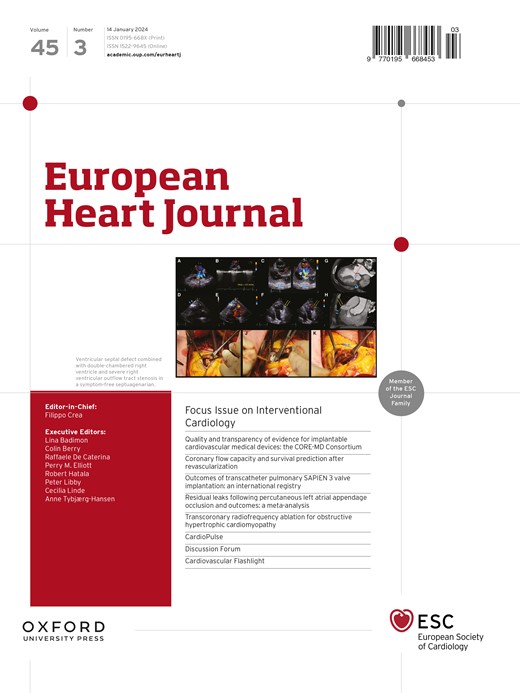Transthyretin amyloid cardiomyopathy: natural history and treatment response assessed by cardiovascular magnetic resonance.
IF 35.6
1区 医学
Q1 CARDIAC & CARDIOVASCULAR SYSTEMS
引用次数: 0
Abstract
BACKGROUND AND AIMS Cardiovascular magnetic resonance (CMR) and extracellular volume (ECV) mapping can measure amyloid burden in vivo. This study sought to assess the natural history of transthyretin amyloid cardiomyopathy (ATTR-CM) in terms of amyloid deposition burden (ECV) over time, changes in cardiac amyloid load following treatment with patisiran, and the association between change in ECV and mortality. METHODS All 189 patients (untreated = 119, patisiran = 70) underwent assessment with CMR at baseline, 160 patients (untreated = 94, patisiran = 66) had a 1-year follow-up CMR and 75 patients (untreated = 42, patisiran = 33) had a 2-year follow-up CMR, of whom 36 patients (untreated = 17, patisiran = 29) had follow-up CMR at both timepoints. CMR response was graded by change in ECV: progression (≥5% increase), stable (<5% change) and regression (≥5% decrease). RESULTS In untreated patients, 36% progressed at 1 year which significantly increased to 62% at 2 years. Mean increase in ECV of 4.1% (after 1 year) and 6.8% (after 2 years) was observed and associated with significant worsening in biomarkers and structural parameters. No significant difference in mean ECV was observed following treatment with patisiran at both timepoints. Stable ECV was observed in 88% of patients (after 1 year) and 100% of patients (after 2 years). Structural parameters remained stable following treatment. ECV progression after 1 year was independently associated with mortality after adjusting for known predictors (hazard ratio 2.021; 95% confidence interval 1.081-3.781; P = .028). CONCLUSIONS CMR with ECV mapping can track changes in cardiac amyloid burden and treatment response in ATTR-CM, with changes in ECV being independently associated with outcomes.转甲状腺素淀粉样心肌病:由心血管磁共振评估的自然病史和治疗反应。
背景和目的心血管磁共振(CMR)和细胞外体积(ECV)作图可以测量体内淀粉样蛋白负荷。本研究旨在评估转甲状腺素淀粉样蛋白心肌病(atr - cm)的自然历史,包括淀粉样蛋白沉积负荷(ECV)随时间的变化,帕西兰治疗后心脏淀粉样蛋白负荷的变化,以及ECV变化与死亡率之间的关系。方法189例患者(未经治疗= 119例,patisiran = 70例)在基线时进行CMR评估,160例患者(未经治疗= 94例,patisiran = 66例)进行1年随访CMR, 75例患者(未经治疗= 42例,patisiran = 33例)进行2年随访CMR,其中36例患者(未经治疗= 17例,patisiran = 29例)在两个时间点进行随访CMR。根据ECV的变化对CMR反应进行分级:进展(增加≥5%)、稳定(变化<5%)和回归(减少≥5%)。结果在未经治疗的患者中,36%的患者在1年内进展,而在2年内显著增加至62%。观察到ECV平均增加4.1%(1年后)和6.8%(2年后),并伴有生物标志物和结构参数的显着恶化。在两个时间点上,帕西兰治疗后的平均ECV无显著差异。88%的患者(1年后)和100%的患者(2年后)观察到稳定ECV。处理后结构参数保持稳定。调整已知预测因子后,1年后ECV进展与死亡率独立相关(风险比2.021;95%置信区间1.081 ~ 3.781;P = .028)。结论scmr与ECV作图可以追踪atr - cm患者心脏淀粉样蛋白负荷的变化和治疗反应,ECV的变化与预后独立相关。
本文章由计算机程序翻译,如有差异,请以英文原文为准。
求助全文
约1分钟内获得全文
求助全文
来源期刊

European Heart Journal
医学-心血管系统
CiteScore
39.30
自引率
6.90%
发文量
3942
审稿时长
1 months
期刊介绍:
The European Heart Journal is a renowned international journal that focuses on cardiovascular medicine. It is published weekly and is the official journal of the European Society of Cardiology. This peer-reviewed journal is committed to publishing high-quality clinical and scientific material pertaining to all aspects of cardiovascular medicine. It covers a diverse range of topics including research findings, technical evaluations, and reviews. Moreover, the journal serves as a platform for the exchange of information and discussions on various aspects of cardiovascular medicine, including educational matters.
In addition to original papers on cardiovascular medicine and surgery, the European Heart Journal also presents reviews, clinical perspectives, ESC Guidelines, and editorial articles that highlight recent advancements in cardiology. Additionally, the journal actively encourages readers to share their thoughts and opinions through correspondence.
 求助内容:
求助内容: 应助结果提醒方式:
应助结果提醒方式:


